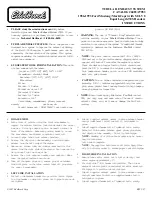
Changing tires with TPMS
It is recommended that you always
have your tires serviced by a dealer
or qualified technician.
Each tire is
equipped with a tire pressure
sensor mounted on the wheel
inside the tire behind the valve
stem. The tire pressure sensor
must be unbolted from the wheel prior to tire removal. The
sensor can be removed by loosening the nut at the valve stem.
Failure to remove the sensor may damage it.
The rubber grommet
(washer) between the wheel and the tire pressure sensor needs to be
replaced when any tire is changed to minimize air leaks.
The tire pressure should be checked periodically (at least monthly) using
a tire gauge, refer to
Checking the tire pressure
in this chapter.
USING SNOW TIRES AND TRACTION DEVICES
Snow tires must be the same size and grade as the tires you
currently have on your vehicle.
The tires on your vehicle have all-weather treads to provide traction in
rain and snow. However, in some climates, using snow tires or traction
devices may be necessary. Ford offers tire cables as a Ford approved
accessory and recommends use of these or SAE class “S”. See your
dealer or qualified service technician for more information on tire cables
for your vehicle.
Follow these guidelines when using snow tires and traction devices:
•
Cables or chains should only be used on the rear wheels.
•
Install cables or chains securely, verifying that the cables or chains do
not touch any wiring, brake lines or fuel lines.
•
Drive cautiously. If you hear the cables or chains rub or bang against
the vehicle, stop and retighten them. If this does not work, remove the
cables or chains to prevent vehicle damage.
•
Avoid overloading your vehicle.
•
Remove the cables or chains when they are no longer needed.
•
Do not use cables or chains on dry roads.
•
Do not exceed 48 km/h (30 mph) with tire cables or chains on your
vehicle.
Maintenance and care
256
















































